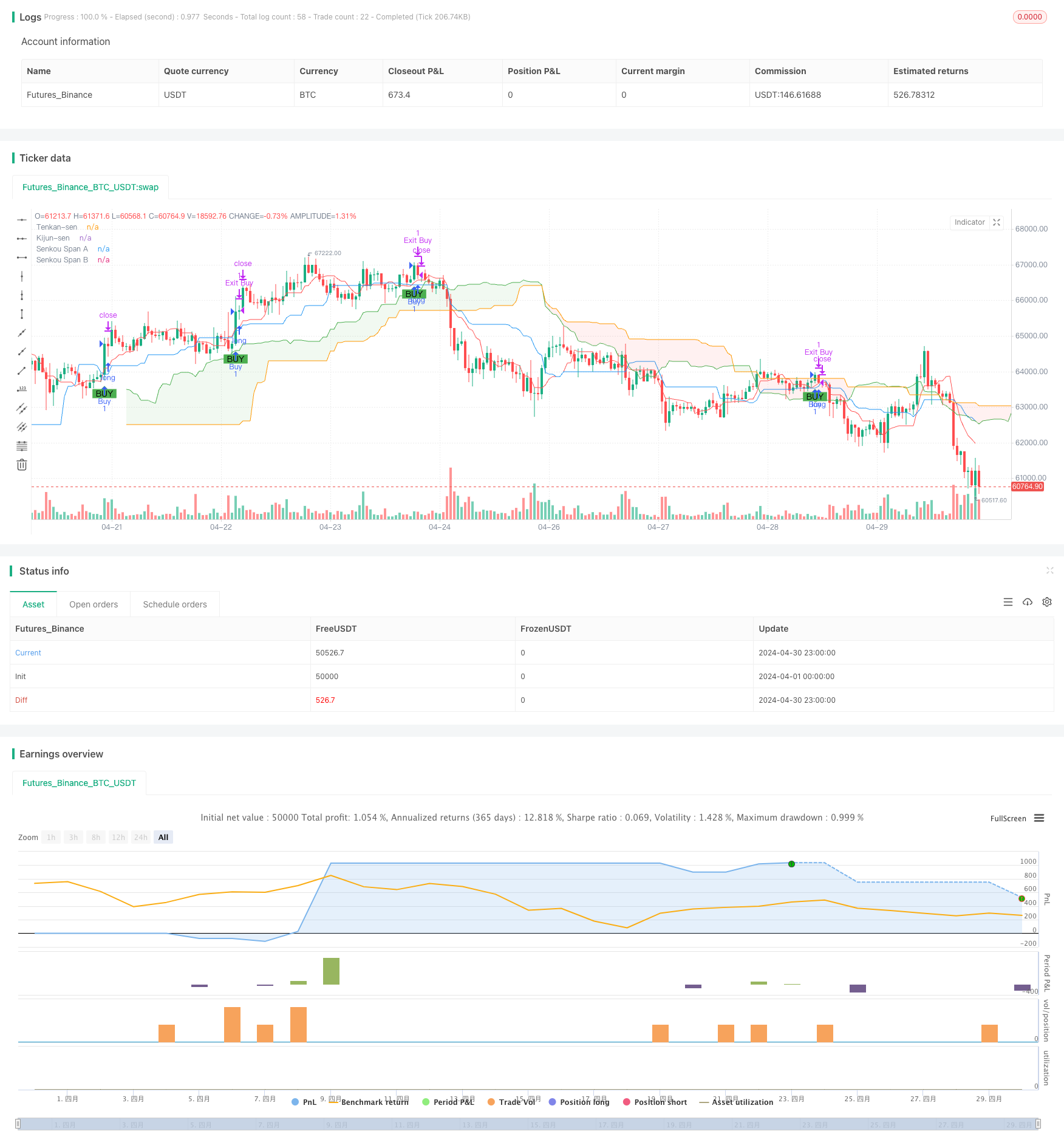
概述
该交易策略结合了MACD和一目均衡图两个技术指标,旨在捕捉中期趋势和动量变化。MACD指标由快速、慢速和信号线组成,分别使用12、26和9的参数设置,用于识别动量转变和趋势反转。一目均衡图包含转折线、基准线、先行上限和先行下限,提供关于趋势强度、方向以及支撑/阻力位的洞察。该策略为积极的交易者提供基于明确定义标准的进场和出场信号,同时考虑风险管理,以保护每笔交易免受过度风险,同时争取可观的利润。
策略原理
该策略利用MACD指标和一目均衡图云来生成买入和卖出信号。当价格超过一目均衡图云且MACD线上穿信号线时,触发买入信号,表明看涨趋势。当价格跌破一目均衡图云且MACD线下穿信号线时,触发卖出信号,表明看跌趋势。止损和止盈水平可根据波动性和历史价格走势进行配置,但初始设置以风险管理为重点,以保护资金并锁定利润。
策略优势
- 结合MACD和一目均衡图两个强大的技术指标,提供更全面和可靠的交易信号。
- 适用于中期交易,捕捉趋势和动量变化。
- 明确定义的买入和卖出标准,易于理解和执行。
- 包含风险管理指南,通过止损和止盈设置保护资金。
- 鼓励根据个人交易风格和股票特点进行优化和定制。
策略风险
- MACD和一目均衡图参数可能不适用于所有市场条件和股票。
- 在波动市场中,频繁的交易信号可能导致过度交易和手续费损失。
- 止损位置如果设置不当,可能导致过早止损或承担过多风险。
- 该策略依赖历史数据,可能无法准确预测未来价格走势。
策略优化方向
- 根据不同股票和市场条件,调整MACD和一目均衡图参数。
- 引入其他技术指标,如相对强弱指数(RSI)或平均真实范围(ATR),以改进信号质量。
- 优化止损和止盈水平,以更好地管理风险和最大化利润。
- 考虑市场情绪和基本面因素,以补充技术分析。
总结
动态MACD和一目均衡图交易策略提供了一种强大的方法,结合两个广受欢迎的技术指标来识别中期趋势和动量变化。通过明确定义的买入和卖出标准,以及风险管理指南,该策略旨在帮助交易者做出明智的决策,控制风险并最大化利润。然而,交易者应根据自己的交易风格和市场特点对策略进行优化和定制,并持续监控其性能。通过适当的调整和风险管理,该策略可成为交易者工具箱中的宝贵补充。
策略源码
/*backtest
start: 2024-04-01 00:00:00
end: 2024-04-30 23:59:59
period: 1h
basePeriod: 15m
exchanges: [{"eid":"Futures_Binance","currency":"BTC_USDT"}]
*/
//@version=5
strategy("MACD and Ichimoku Cloud Strategy", overlay=true)
// MACD Components
fastLength = 12
slowLength = 26
signalLength = 9
[macdLine, signalLine, _] = ta.macd(close, fastLength, slowLength, signalLength)
// Ichimoku Cloud Components
tenkanLength = 9
kijunLength = 26
senkouLength = 52
displacement = 26
tenkanSen = (ta.highest(high, tenkanLength) + ta.lowest(low, tenkanLength)) / 2
kijunSen = (ta.highest(high, kijunLength) + ta.lowest(low, kijunLength)) / 2
senkouSpanA = (tenkanSen + kijunSen) / 2
senkouSpanB = (ta.highest(high, senkouLength) + ta.lowest(low, senkouLength)) / 2
chikouSpan = close[displacement]
// Plot Ichimoku Cloud
plot(tenkanSen, color=color.red, title="Tenkan-sen")
plot(kijunSen, color=color.blue, title="Kijun-sen")
p1 = plot(senkouSpanA, color=color.green, title="Senkou Span A", offset=displacement)
p2 = plot(senkouSpanB, color=color.orange, title="Senkou Span B", offset=displacement)
fill(p1, p2, color=senkouSpanA > senkouSpanB ? color.new(color.green, 90) : color.new(color.red, 90))
// Define Buy and Sell Conditions
macdBuy = ta.crossover(macdLine, signalLine)
ichimokuBuy = (close > senkouSpanA) and (close > senkouSpanB) and (tenkanSen > kijunSen)
buySignal = macdBuy and ichimokuBuy
macdSell = ta.crossunder(macdLine, signalLine)
ichimokuSell = (close < senkouSpanA) and (close < senkouSpanB) and (tenkanSen < kijunSen) and (tenkanSen[displacement] < math.min(senkouSpanA, senkouSpanB))
sellSignal = macdSell and ichimokuSell
// Execute Buy or Sell orders
if (buySignal)
strategy.entry("Buy", strategy.long)
if (sellSignal)
strategy.entry("Sell", strategy.short)
// Setting up the stop loss and take profit
stopLossPerc = 5.0
takeProfitPerc = 10.0
strategy.exit("Exit Buy", "Buy", loss=stopLossPerc, profit=takeProfitPerc)
strategy.exit("Exit Sell", "Sell", loss=stopLossPerc, profit=takeProfitPerc)
// Plot Buy and Sell Signals
plotshape(series=buySignal, location=location.belowbar, color=color.green, style=shape.labelup, title="Buy Signal", text="BUY")
plotshape(series=sellSignal, location=location.abovebar, color=color.red, style=shape.labeldown, title="Sell Signal", text="SELL")
相关推荐